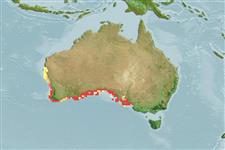Environment: milieu / climate zone / depth range / distribution range
นิเวศวิทยา
เกี่ยวกับทะเล,น้ำเค็ม สัตว์น้ำหน้าดิน. Temperate; 25°S - 37°S
Eastern Indian Ocean: endemic to Australia.
ขนาด / น้ำหนัก / Age
Maturity: Lm ? range ? - ? cm
Max length : 12.0 cm TL เพศผู้/กระเทย; (Ref. 9563)
A temperate species found inshore on reefs (Ref. 7300).
Life cycle and mating behavior
Maturities | การสืบพันธุ์ | Spawnings | Egg(s) | Fecundities | ตัวอ่อน
May, J.L. and J.G.H. Maxwell, 1986. Trawl fish from temperate waters of Australia. CSIRO Division of Fisheries Research, Tasmania. 492 p. (Ref. 9563)
IUCN Red List Status (Ref. 130435)
Human uses
เครื่องมือ
Special reports
Download XML
แหล่งที่มาจากอินเตอร์เน็ต
Estimates based on models
Preferred temperature (Ref.
123201): 16.3 - 20.6, mean 18 °C (based on 133 cells).
Phylogenetic diversity index (Ref.
82804): PD
50 = 0.5156 [Uniqueness, from 0.5 = low to 2.0 = high].
Bayesian length-weight: a=0.01122 (0.00514 - 0.02450), b=3.04 (2.87 - 3.21), in cm total length, based on all LWR estimates for this body shape (Ref.
93245).
ระดับชั้นอาหาร (Ref.
69278): 3.4 ±0.3 se; based on diet studies.
Fishing Vulnerability (Ref.
59153): Low vulnerability (10 of 100).
Nutrients (Ref.
124155): Calcium = 80.9 [38.4, 188.9] mg/100g; Iron = 0.477 [0.249, 0.887] mg/100g; Protein = 17.1 [15.7, 18.5] %; Omega3 = 1.06 [0.44, 2.97] g/100g; Selenium = 10.3 [4.7, 25.2] μg/100g; VitaminA = 35.8 [10.0, 119.2] μg/100g; Zinc = 0.886 [0.602, 1.312] mg/100g (wet weight);
